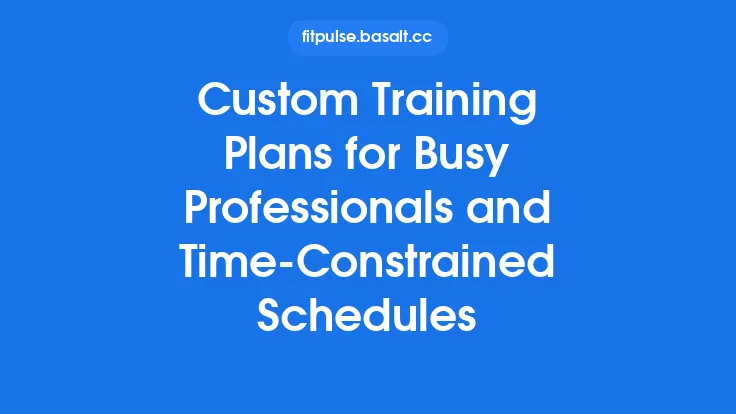A hectic schedule often leaves little room for dedicated mobility work, yet the cumulative cost of neglecting joint health can manifest as stiffness, reduced performance, and a higher risk of injury. The good news is that a well‑structured 10‑minute mobility flow can deliver measurable improvements in range of motion, movement quality, and overall comfort without demanding a large time commitment. By focusing on high‑impact, multi‑joint movements and employing efficient sequencing, you can reap the benefits of a full‑body mobility session in the time it takes to brew a cup of coffee.
Why a Time‑Efficient Mobility Flow Matters
- Physiological Reset: Short, dynamic movements stimulate synovial fluid production, lubricating joints and enhancing nutrient delivery to cartilage.
- Neuromuscular Re‑education: Brief, purposeful patterns reinforce proper motor patterns, helping the nervous system “re‑learn” optimal movement pathways.
- Stress Mitigation: Even a few minutes of coordinated movement paired with controlled breathing can lower cortisol levels, offering a mental reset during a busy day.
- Compliance: The shorter the routine, the more likely it is to become a habit. Consistency trumps duration when it comes to long‑term mobility gains.
Core Principles of a 10‑Minute Flow
- Multi‑Joint Efficiency: Choose exercises that simultaneously address several joints (e.g., hip‑spine‑shoulder chains) to maximize coverage.
- Progressive Overlap: Overlap the end of one movement with the start of the next to eliminate dead time.
- Controlled Tempo: Use a 2‑second eccentric (lengthening) phase, a brief pause, and a 2‑second concentric (shortening) phase to balance flexibility and strength.
- Breath‑Movement Synchrony: Inhale during lengthening, exhale during shortening to enhance intra‑abdominal pressure and joint stability.
- Scalable Load: Incorporate optional props (e.g., a yoga block or resistance band) for added challenge without extending the session.
Anatomy of the Routine: Segment Breakdown
1. Micro‑Warm‑Up (≈30 seconds)
A rapid activation of the posterior chain and core prepares the nervous system.
- Cat‑Cow Variations: 5 cycles, moving from spinal flexion to extension while maintaining a neutral pelvis.
2. Dynamic Joint Activation (≈3 minutes)
Target the major mobility bottlenecks most people experience: hips, thoracic spine, shoulders, and ankles.
- Hip‑Circles with Opposite Arm Reach: 30 seconds each side.
- Thoracic Rotations in Quadruped: 30 seconds each side.
- Scapular Wall Slides: 45 seconds.
- Ankle Dorsiflexion Rock‑Backs: 45 seconds.
3. Integrated Flow Patterns (≈5 minutes)
These sequences blend the previously mobilized joints into fluid, functional patterns.
- World’s Greatest Stretch (Modified): 1 minute total, alternating sides.
- Lunge‑Twist‑Reach: 1 minute, alternating legs.
- Standing Figure‑Four Mobilizer: 1 minute, alternating legs.
- Reverse Snow‑Angel: 1 minute, focusing on shoulder and thoracic mobility.
- Dynamic Kneeling Hip Flexor Stretch with Arm Extension: 1 minute, alternating sides.
4. Micro‑Cool‑Down (≈30 seconds)
A brief return to a neutral state, allowing the nervous system to settle.
- Deep Diaphragmatic Breath with Gentle Neck Rolls: 30 seconds.
Detailed 10‑Minute Sequence
| Time | Movement | Key Cues | Modifications |
|---|---|---|---|
| 0:00‑0:30 | Cat‑Cow (Quadruped) | Initiate movement from the mid‑spine, keep hips level. | Perform seated on a chair if floor work is uncomfortable. |
| 0:30‑1:30 | Hip‑Circle + Opposite Arm Reach | Draw a large circle with the knee, reach opposite hand overhead. | Reduce circle radius; keep arm on hip if balance is an issue. |
| 1:30‑2:00 | Thoracic Rotation (Quadruped) | Keep hips stable, rotate upper back, gaze toward the moving hand. | Perform seated thoracic twists if needed. |
| 2:00‑2:45 | Scapular Wall Slides | Press forearms against wall, slide up while maintaining contact. | Use a towel for tactile feedback if wall contact is hard. |
| 2:45‑3:30 | Ankle Dorsiflexion Rock‑Backs | Start with heel on ground, rock forward onto toes, then back. | Perform with a small step for added stability. |
| 3:30‑4:30 | World’s Greatest Stretch (Modified) | Lunge forward, rotate torso, reach arm toward ceiling, then return. | Skip the rotation if spinal mobility is limited; focus on hip flexor stretch. |
| 4:30‑5:30 | Lunge‑Twist‑Reach | From a forward lunge, twist torso toward front leg, extend opposite arm. | Keep torso upright without twist if rotation is uncomfortable. |
| 5:30‑6:30 | Standing Figure‑Four Mobilizer | Cross ankle over opposite knee, hinge at hips, reach arms overhead. | Perform seated if balance is a concern. |
| 6:30‑7:30 | Reverse Snow‑Angel | Lie prone, lift chest slightly, sweep arms from hips to overhead, keeping scapula retracted. | Perform standing with a resistance band for a similar pattern. |
| 7:30‑8:30 | Kneeling Hip Flexor Stretch + Arm Extension | Kneel, shift weight forward, extend opposite arm overhead, then switch. | Perform a standing hip flexor stretch if kneeling is painful. |
| 8:30‑9:00 | Deep Diaphragmatic Breath + Neck Rolls | Inhale expanding belly, exhale slowly, roll neck gently each side. | Omit neck rolls if cervical discomfort exists. |
| 9:00‑10:00 | Transition to Activity | Stand, shake out limbs, take a final deep breath, and move into the next task. | — |
Breathing & Neuromuscular Coordination
Synchronizing breath with movement is more than a calming technique; it directly influences joint stability. Intra‑abdominal pressure generated during exhalation supports the lumbar spine, while inhalation during lengthening phases encourages a gentle stretch without excessive tension. Encourage practitioners to adopt a 2‑2‑2 rhythm (2 seconds inhale, 2 seconds hold, 2 seconds exhale) for the majority of the flow, adjusting only when a movement demands a different cadence.
Scaling & Progression Strategies
- Load Addition: Incorporate a light resistance band around the thighs during hip circles or ankle dorsiflexion to increase proprioceptive demand.
- Range Extension: Gradually increase the amplitude of each movement by a few centimeters each week.
- Tempo Variation: Shift from a 2‑second eccentric/concentric pattern to a 3‑second eccentric for deeper tissue loading.
- Complexity Upgrade: Combine two adjacent movements into a seamless transition (e.g., moving directly from the World’s Greatest Stretch into the Lunge‑Twist‑Reach without resetting).
Integrating the Flow into a Busy Day
- Micro‑Break Slots: Use calendar alerts to schedule three 3‑minute “movement windows” throughout the day; each window can host half the routine.
- Desk‑Friendly Adaptations: Perform the micro‑warm‑up, hip circles, and scapular slides while seated or standing near a workstation.
- Travel Pack: A lightweight yoga mat and a resistance band occupy less than 200 g, fitting easily into a laptop bag for on‑the‑go sessions.
- Trigger‑Based Execution: Pair the flow with routine triggers—after a bathroom break, before a meeting, or immediately after returning home.
Tracking Progress & Measuring Benefits
- Joint Angle Tests: Use a goniometer app to record baseline hip flexion, thoracic rotation, and ankle dorsiflexion; re‑measure monthly.
- Movement Quality Rating: Rate each exercise on a 1‑10 scale for ease, control, and comfort; look for upward trends.
- Subjective Metrics: Log perceived stiffness, energy levels, and any reduction in discomfort after each week of consistent practice.
- Performance Correlates: Note improvements in everyday tasks—easier squatting to pick up objects, smoother reaching overhead, or reduced lower‑back fatigue after prolonged sitting.
Common Pitfalls & How to Avoid Them
| Pitfall | Why It Happens | Solution |
|---|---|---|
| Rushing Through Movements | Perceived time pressure | Prioritize quality; a slower, controlled 10‑minute session beats a hurried 5‑minute one. |
| Ignoring Pain Signals | Desire to “push through” | Stop immediately if sharp pain arises; modify or skip the offending movement. |
| Skipping the Micro‑Warm‑Up | Belief it’s unnecessary | The warm‑up primes the nervous system; without it, joint loading can be abrupt. |
| Over‑reliance on Props | Assuming bands replace proper technique | Use props only to augment, never to compensate for poor form. |
| Inconsistent Timing | Variable daily schedules | Set a fixed cue (e.g., after the first cup of coffee) to anchor the routine. |
Closing Thoughts
A concise, 10‑minute mobility flow is a powerful tool for anyone juggling a demanding schedule. By adhering to principles of multi‑joint efficiency, breath‑movement integration, and progressive overload, the routine delivers lasting improvements in joint health, movement confidence, and overall well‑being. The evergreen nature of this approach—rooted in anatomy, biomechanics, and habit formation—means it remains relevant regardless of evolving fitness trends or lifestyle changes. Commit to the ten minutes, respect the body’s feedback, and watch everyday movement become smoother, stronger, and more enjoyable.





